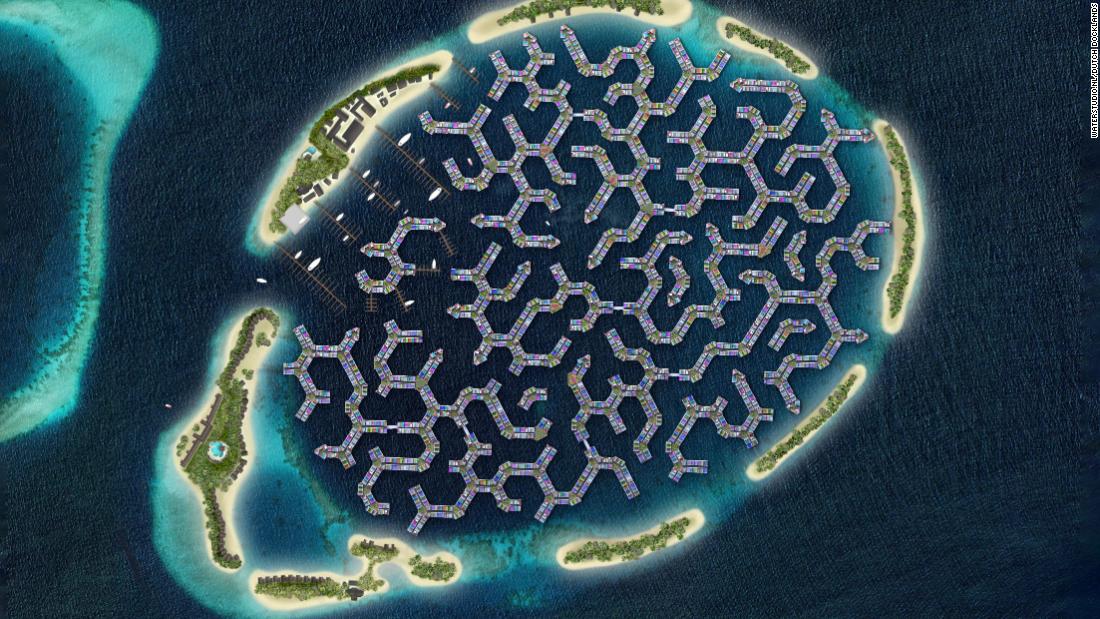A city rises from the waters of the Indian Ocean. A floating city big enough for 20,000 people is being built in a turquoise lagoon just 10 minutes by boat from Male, the capital of the Maldives.
The city, designed in a pattern similar to a brain coral, will consist of 5,000 floating units including homes, restaurants, shops and schools, with canals running between them. The first units will be unveiled this month, residents will begin moving in early 2024, and the entire city is expected to be complete by 2027.
The project – a joint venture between property developer Dutch Docklands and the Maldives government – is not intended as a wild experiment or futuristic vision: it is being built as a practical solution to the harsh reality of sea level rise.
Do you want to future-proof your home against rising sea levels? let it float
But if a city floats, it could rise with the sea. This is “new hope” for the more than half a million people in the Maldives, said Koen Olthuis, founder of Waterstudio, the architecture firm that designed the city. “It can prove that there is affordable housing, large communities and normal cities on the water that are also safe. They (Maldives) will go from climate refugees to climate innovators,” he told CNN.
Hub of floating architecture
Born and raised in the Netherlands – where about a third of the country lies below sea level – Olthuis has been around water all his life. His mother’s family was shipbuilders and his father came from a line of architects and engineers, so it seemed natural to combine the two, he said. In 2003, Olthuis founded Waterstudio, an architectural office dedicated exclusively to building on water.
At the time, there were signs of climate change, but the problem wasn’t considered big enough to build a business around, he said. The biggest problem at the time was space: Cities were growing, but suitable areas for new urban developments were running out.
The headquarters of the Global Center on Adaptation is anchored in the Nieuwe Maas in Rotterdam. Recognition: Marcel IJzerman
In recent years, however, climate change has become a “catalyst” pushing floating architecture into the mainstream, he said. Over the past two decades, Waterstudio has designed more than 300 floating homes, offices, schools and health centers around the world.
Patrick Verkooijen, CEO of GCA, sees floating architecture as a practical and economically smart solution to rising sea levels.
“The cost of not adapting to these flood risks is extraordinary,” he told CNN. “We have a choice: either we delay and pay, or we plan and prosper. Floating offices and floating buildings are part of this planning against the climate of the future.”
But despite the momentum in recent years, floating architecture still has a long way to go in terms of scale and affordability, Verkooijen said. “This is the next step on this journey: how can we scale and accelerate at the same time? Size and speed are badly needed.”
A normal city, only brisk
The town of Waterstudio is designed to attract locals with its rainbow-colored houses, wide balconies and ocean views. Residents get around on boats, or they can walk, bike, or ride electric scooters or buggies on the sandy roads.

The capital of the Maldives is massively overcrowded, with no space to stretch out except into the sea. Recognition: Carl Court/Getty Images AsiaPac
The modular units will be built at a local shipyard and then towed to the floating city. Once in position, they are attached to a large underwater concrete hull that is bolted to the seabed on telescopic steel stilts, allowing it to sway gently with the waves. Coral reefs surrounding the city help create a natural breakwater, stabilizing it and preventing residents from feeling seasick.
Olthuis said the structure’s potential environmental impact was rigorously assessed by local coral experts and approved by government agencies before construction began. To support sea life, foam glass artificial coral reefs are connected to the city’s underside, which he says help stimulate natural coral growth.
The goal is for the city to be self-sufficient and have the same functions as on land. There will be electricity powered primarily by on-site generated solar energy and wastewater will be treated on-site and reused as fertilizer for crops. As an alternative to air conditioning, the city will use deep-sea cooling, pumping cold water from the deep sea into the lagoon to save energy.
By developing a fully functioning floating city in the Maldives, Olthuis hopes to take this type of architecture to the next level. It will no longer be the “freak architecture” found in luxurious places commissioned by the super-rich, but an answer to climate change and urbanization that is both practical and affordable, he said.
“If I want to make a difference as an architect, we have to expand,” he said.




